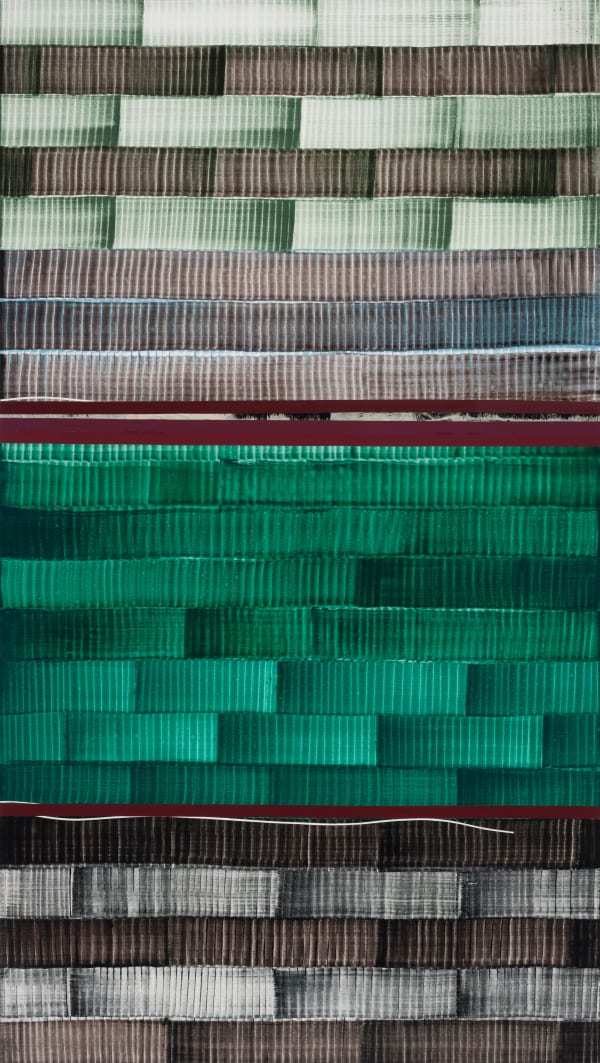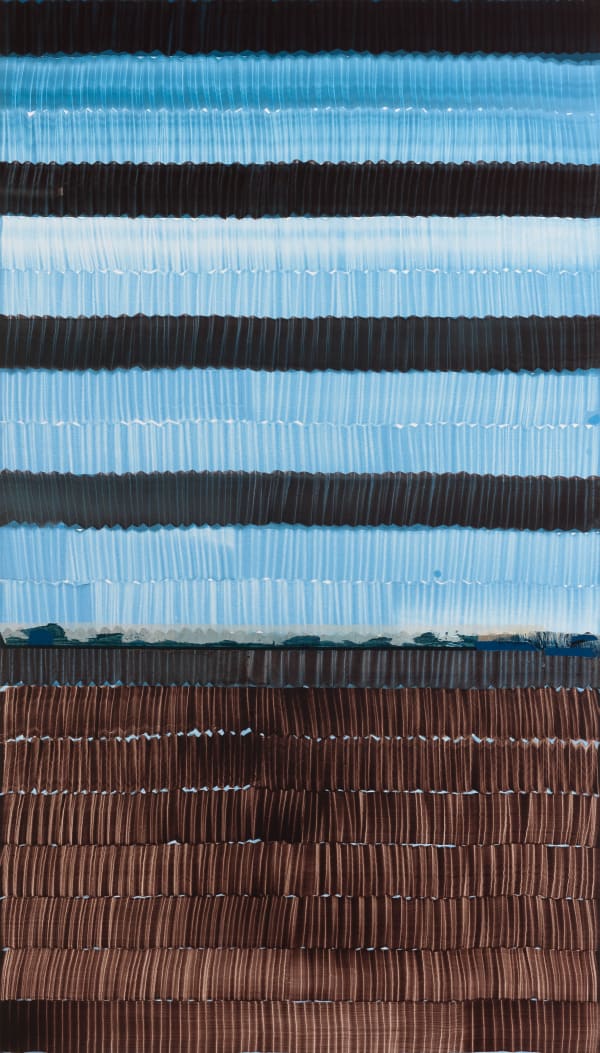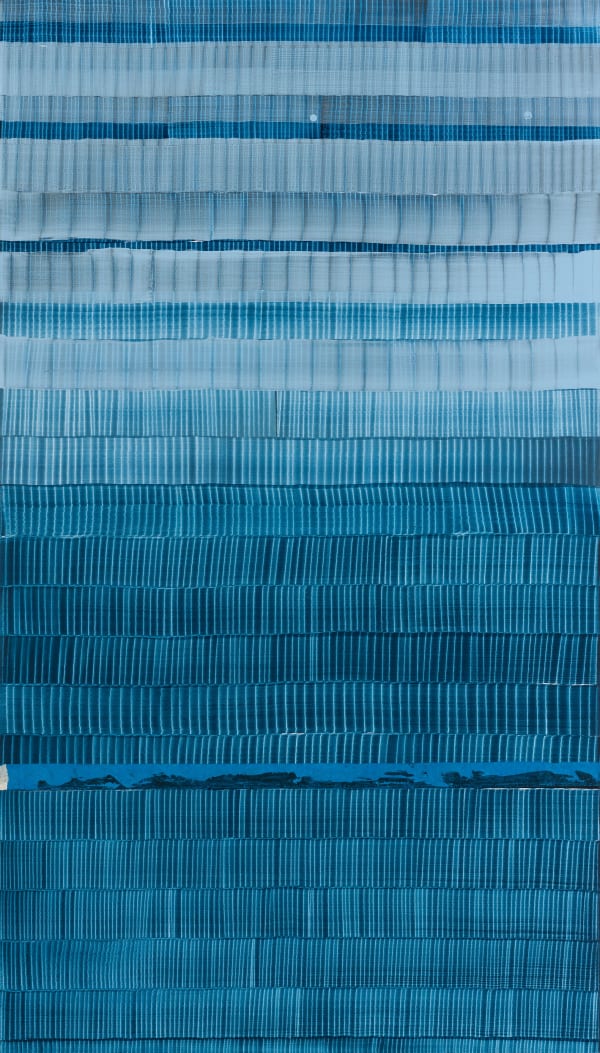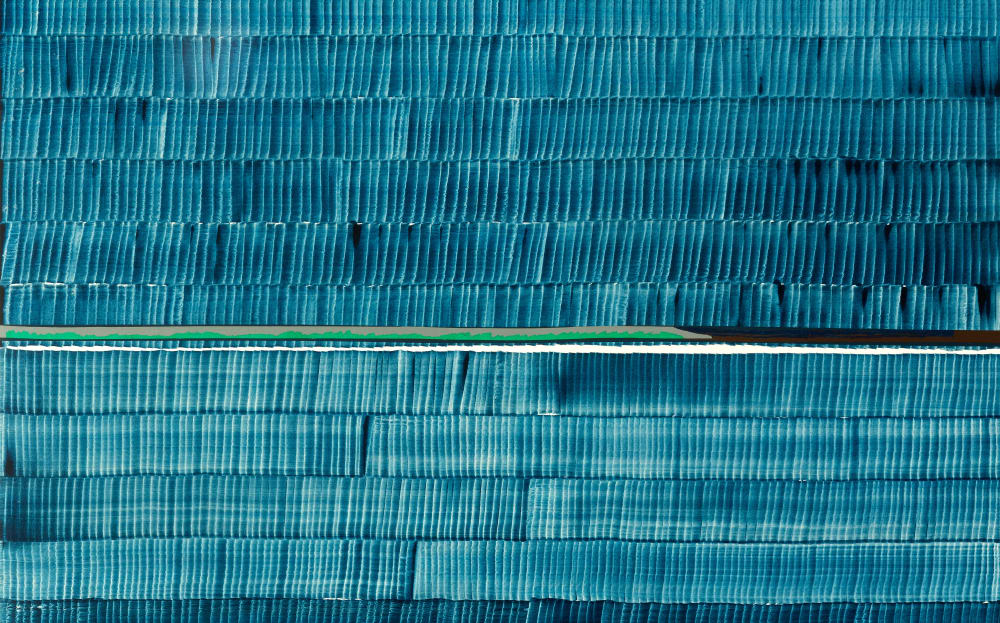NORTE ABIERTO: JUAN USLÉ
-
Introduction
Repetitions and variations radiate across a series of new medium-scale paintings by Juan Uslé in Norte Abierto at Galerie Thomas Schulte. Opening on the occasion of Berlin Art Week, the exhibition marks the artist’s ninth solo exhibition at the gallery.
In elongated, vertical canvases comprising horizontal rows of stacked brushstrokes, Uslé’s paintings are full of oscillations: gradients in a state of flux. As well as contradictions: they are paced and structured though meandering, marked by lyrical turns. The environments they open up are woven from continuous, processual paths that are nonetheless susceptible to sudden shifts, interruptions and moments of pause.
This openness and continuity filters through the works in the exhibition. Heaven adventure, for example, conjures an upward motion. A horizontal series of dark brown bars frame expanses of blue, like the rungs of a ladder, or the windows of a highrise building – towering up beyond the edge of the canvas, stretching ever taller. Perhaps we’re seeing the sky, or a reflection of it against transparent glass panes. Wavering someplace between natural landscape and urban architecture, the work offers a vague orientation – further underlined by a subtle yet incongruous strip that cuts between the image’s top and bottom sections like a horizon line. But even within the bands of metallic dark brown that constitute the painting’s bottom third, light blue shines through in small flashes between fissures, unsettling a prescribed relationship between earth and sky.
Here, the rows of brushstrokes are fluid, gently folding ribbons that glimmer like satin and flow like waves – undulating between flatness and depth. There’s an airiness to them, as though they never fully touch down on the surface, but only lightly graze it. With a translucent iridescence like crepe paper, it seems implausible that such a structure can remain intact.
It is in this sense of adventure that we find our way into Uslé’s paintings – to be immersed in the experience of them. Or, taking into account the liquid character of their medium: submerged. This perception is prompted by another work in dialogue with Heaven adventure, titled Rumor Sumergido. The rhythms and shades of the monochromatic blue painting reach another level of depth and expansiveness, conveying a particular sensitivity to fluctuations in light and motion. Its overlapping of rows, brushstrokes and blues produce a gridlike effect in places, similar to a woven textile – complete with wobbly edges, frays, folds and inconsistencies. Once again, there is an upward motion: darker, more dense blues flood the bottom half, giving way to paler shades, light and space near the top. There’s a sensation of drifting up from the water’s depths to its surface, or moving from night into day. Within this expanse, small points of light appear like lens flare, and brush marks become electrically illuminated. A clash of wave-like blues again forms a horizon of sorts, here buried in the painting’s bottom third.
Such horizontal movement is turned over in Tres veces más – in effect bringing moments of interference and unexpected shifts not only into individual works, but across the group of paintings as a whole. Here, the consecutive bands of brushstrokes that run vertically up and down the canvas come to resemble streets in aerial view or a cropping of skyscrapers. There are two prominent colors: deep teal and muted lavender. While bright segues into bold yellow, red and blue run under, trail off and break with the image’s more or less consistent vertical edges in a cluster of slender cables. Here, the work’s currents and waves become more electrically charged: both in the wiry strands of primary colors, as well as their glitchy presence. We can follow along similar lines into Ahí vivía yo, where parallel stripes of blue and red find stable ground at the painting’s center. And further still, into Oculto en la belleza, a striking canvas primarily consumed by reds that flicker like static noise.
Throughout, there’s a visible change in tempo that occurs, like fastforwarding, slowing down or rewinding a film. The pace and direction of Uslé’s marks and the resulting light that shimmers from them take on different effects, carrying distinct emphases and intonations: at times soft, curved and sprawling, at others more tightly sequenced and flattened out.
In accumulations of time, color, gestures and signs, the repetitional continuity of the works gives way to a richly layered fabric, a constellation of experiences and sensations. We can peer through the cracks and slippages, soak up the reflections that bounce off the surface, follow the threads that construct the whole – line by line, row by row. Like screens, they offer glimpses into another layer of reality, another place, which only unfolds as we navigate through. What Uslé guides us towards is something submerged, hidden – lying just behind, or just beyond, and continuing just out of view.Text by Julianne Cordray
-
Installation Views
-
Works
-
Inquire about works by Juan Uslé

-
Artists on view










